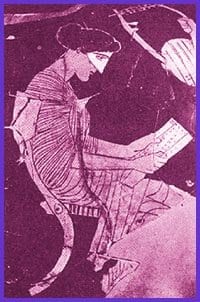Is lesbianism older than gay sex?
“Until recently lesbianism has been looked at as sort of an afterthought to homosexuality, which (like most gender-neutral terms) really refers primarily to males,” says professor David Halperin of the University Of Michigan.
“But new research suggests a different chronology for male and female homosexuality. Lesbianism may in fact be older.”
Halperin says “lesbian” is the most ancient expression that refers to sexuality in contemporary vocabulary. It comes from the isle of Lesbos in the Aegean sea, where Sappho composed poems about her desire for the girls and women of the island in the seventh century BC.
Despite its age, it was not used by most female homosexuals until the lesbian-feminist movement of the late 20th century. Words like “queer,” “gay” or “invert” were used up to the 1960s.
So understanding the word is recent. In Aldous Huxley’s 1923 novel, Antic Hay, “lesbian experiences” refers to a man’s naughty heterosexual dalliance.
“The transformation of ‘lesbian’ into the proper name of a particular sexual orientation, into a shorthand for ‘female homosexual,’ took a very long time,” says Halperin.
Sappho’s interest in other women was not considered notable to the classical Greeks. The women of Lesbos were known as exceptionally sensual, but it wasn’t until more than 600 years later that the same-sex nature of their desire became their claim to fame.
In fact the ancient Greek verb “lesbiazein” was not connected to homosexuality, but fellatio.
The term more commonly used in antiquity for female homosexuality was tribadism. However, Halperin warns that there are still significant differences between the ancient tribade and the contemporary lesbian.
“A tribade is a gender deviant woman who is masculine and phallic, who fucks other women and boys. She practises male pursuits like wrestling, drinks and vomits like a man…. Tribadism has more to do with gender than sexuality.”
A popular vocabulary for describing sex between women developed from the Renaissance on. By the end of the 18th century, “tribade” and “lesbian” or “sapphist” began to be used interchangeably to refer to women who desired other women.
Halperin, who’s best known for his book One Hundred Years Of Homosexuality, discusses the chronology of lesbianism later this year in the anthology The Night Of Reason (from the University Of Chicago Press).
The article is a response to lesbian scholars suggesting the possibility that, even without a single name for it, a category of female same-sex love was instilled in the popular imagination significantly earlier than was male homosexuality.
According to Halperin, tracing the independent time-line of female homosexuality demands attention. It’s an antidote to the common claim that women’s desire was invisible in the past. However, he warns against reading contemporary notions of sexuality too literally into the ancient world.
For example, astrologers of the Roman empire believed that certain configurations of stars would cause the women born under them to be tribades or viragoes – masculine, phallic women.
Queer scholars have seen this as an early notion of sexual orientation. But the astrologers included in their descriptions other factors that don’t connect: age, wealth, status, and whether or not the person to whom one is attracted is a foreigner.
“I don’t mean to sabotage the whole enterprise of gay and lesbian history by saying we aren’t everywhere,” says Halperin. “If these figures weren’t exactly female homosexuals, they certainly weren’t straight, either.”
But Halperin is skeptical of historical methodology that imposes a familiar, contemporary world-view on unfamiliar, geographically and historically distant moments.
“I think it’s more useful to document the diversity of sexual systems that have existed and focus our attention on the peculiarities of our own system,” says Halperin. “This highlights that it’s really quite strange (as opposed to natural) to be living in a place and time of compulsory and enforced heterosexuality.”

 Why you can trust Xtra
Why you can trust Xtra


